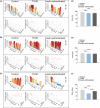Integrated pancreatic microcirculatory profiles of streptozotocin-induced and insulin-administrated type 1 diabetes mellitus
- PMID: 33655585
- PMCID: PMC8365673
- DOI: 10.1111/micc.12691
Integrated pancreatic microcirculatory profiles of streptozotocin-induced and insulin-administrated type 1 diabetes mellitus
Abstract
Objective: As an integrated system, pancreatic microcirculatory disturbance plays a vital role in the pathogenesis of type 1 diabetes mellitus (T1DM), which involves changes in microcirculatory oxygen and microhemodynamics. Therefore, we aimed to release type 1 diabetic and insulin-administrated microcirculatory profiles of the pancreas.
Methods: BALB/c mice were assigned to control, T1DM, and insulin-administrated groups randomly. T1DM was induced by intraperitoneal injection of streptozotocin (STZ). 1.5 IU insulin was administrated subcutaneously to keep the blood glucose within the normal range. After anesthetizing by isoflurane, the raw data set of pancreatic microcirculation was collected by the multimodal device- and computer algorithm-based microcirculatory evaluating system. After adjusting outliers and normalization, pancreatic microcirculatory oxygen and microhemodynamic data sets were imported into the three-dimensional module and compared.
Results: Microcirculatory profiles of the pancreas in T1DM exhibited a loss of microhemodynamic coherence (significantly decreased microvascular blood perfusion) accompanied by an impaired oxygen balance (significantly decreased PO2 , SO2 , and rHb). More importantly, with insulin administration, the pathological microcirculatory profiles were partially restored. Meanwhile, there were correlations between pancreatic microcirculatory blood perfusion and PO2 levels.
Conclusions: Our findings establish the first integrated three-dimensional pancreatic microcirculatory profiles of STZ-induced and insulin-administrated T1DM.
Keywords: insulin; microhemodynamics; oxygen; pancreatic microcirculation; type 1 diabetes mellitus.
© 2021 The Authors. Microcirculation published by John Wiley & Sons Ltd.
Conflict of interest statement
The authors declare no conflict of interest.
Figures








Similar articles
-
Role of insulin in pancreatic microcirculatory oxygen profile and bioenergetics.World J Diabetes. 2022 Sep 15;13(9):765-775. doi: 10.4239/wjd.v13.i9.765. World J Diabetes. 2022. PMID: 36188151 Free PMC article.
-
Multimodal Device and Computer Algorithm-Based Monitoring of Pancreatic Microcirculation Profiles In Vivo.Pancreas. 2020 Sep;49(8):1075-1082. doi: 10.1097/MPA.0000000000001627. Pancreas. 2020. PMID: 32769856 Free PMC article.
-
Harnessing the benefits of glycine supplementation for improved pancreatic microcirculation in type 1 diabetes mellitus.Microvasc Res. 2024 Jan;151:104617. doi: 10.1016/j.mvr.2023.104617. Epub 2023 Oct 31. Microvasc Res. 2024. PMID: 37918522
-
Insulin protects against type 1 diabetes mellitus-induced ultrastructural abnormalities of pancreatic islet microcirculation.Microscopy (Oxf). 2020 Dec 3;69(6):381-390. doi: 10.1093/jmicro/dfaa036. Microscopy (Oxf). 2020. PMID: 32648910 Free PMC article.
-
Insulin treatment restores islet microvascular vasomotion function in diabetic mice.J Diabetes. 2017 Oct;9(10):958-971. doi: 10.1111/1753-0407.12516. Epub 2017 Feb 21. J Diabetes. 2017. PMID: 27976498
Cited by
-
Histopathological examination of the protective effect of intense exercise in apoptotic germ cell damage due to diabetes.Acta Cir Bras. 2023 Apr 21;38:e381423. doi: 10.1590/acb381423. eCollection 2023. Acta Cir Bras. 2023. PMID: 37098926 Free PMC article.
-
Interdisciplinary perspectives on diabetes and microcirculatory dysfunction: A global bibliometric analysis.World J Diabetes. 2025 Feb 15;16(2):97271. doi: 10.4239/wjd.v16.i2.97271. World J Diabetes. 2025. PMID: 39959278 Free PMC article.
-
Remodeling of the periodontal ligament and alveolar bone during axial tooth movement in mice with type 1 diabetes.Front Endocrinol (Lausanne). 2023 Jan 23;14:1098702. doi: 10.3389/fendo.2023.1098702. eCollection 2023. Front Endocrinol (Lausanne). 2023. PMID: 36755916 Free PMC article.
-
Role of insulin in pancreatic microcirculatory oxygen profile and bioenergetics.World J Diabetes. 2022 Sep 15;13(9):765-775. doi: 10.4239/wjd.v13.i9.765. World J Diabetes. 2022. PMID: 36188151 Free PMC article.
References
-
- Inanc M, Tekin K, Kiziltoprak H, et al. Changes in retinal microcirculation precede the clinical onset of diabetic retinopathy in children with type 1 diabetes mellitus. Am J Ophthalmol. 2019;207:37‐44. - PubMed
Publication types
MeSH terms
Substances
LinkOut - more resources
Full Text Sources
Other Literature Sources
Medical
Research Materials

